Lessons Learned as a First Responder to Hurricane Harvey
Lessons Learned as a First Responder to Hurricane Harvey
Late Sunday evening, we drove south down an eerily empty highway. While one wouldn’t expect much traffic in north Houston on a Sunday after dark, a major highway with no cars whatsoever tends to give one pause. Further compounding the eeriness was the sheer darkness due to power outages; no streetlights or no town lights, just what we could see illuminated by our headlights. It was like driving in a bubble where the only world that existed was our own.
The rain and wind were relentless; we’d entered the outer bands of Hurricane Harvey about an hour south of Waco, a definitive storm on the horizon that we could discern from quite a ways out. The wind and rain howled from left to right as we drove deeper and deeper into the circulation; we had no real plan, only that we knew people needed help. That help would come in the form of volunteers like us, armed with boats, preparation and the altruistic spirit of helping our fellow man.
Lessons from Hurricane Harvey
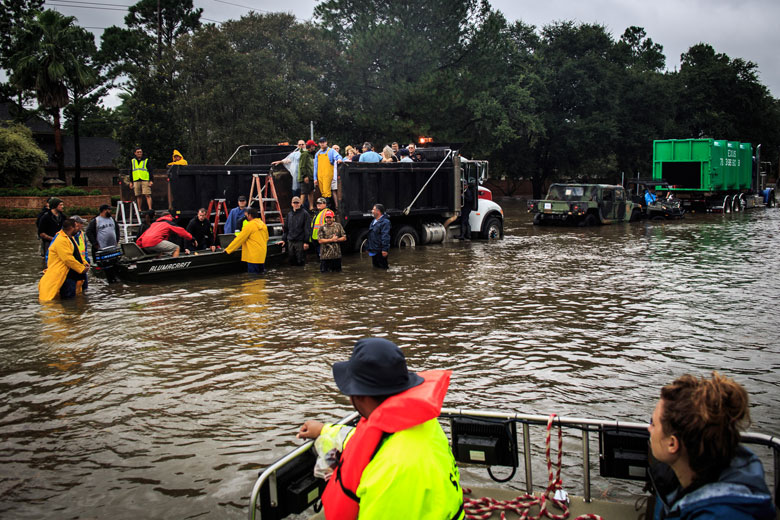
I’d been watching Hurricane Harvey from early on, as I do with most weather events, it’s what I do as a Storm Chaser. As zero hour drew near I became exceedingly confidant that Harvey would be one for the books. The hurricane was large and slow moving, the type of storm conducive to extreme levels of flooding. As forecast, it impacted the Texas coast after bringing it to a near halt. Harvey sat there dumping trillions of gallons of water on the Houston area and the situation for many folks grew dire. This was a once in a lifetime event, one could live another hundred years and never see the levels of rain and flooding that occurred in Houston. The hurricane ultimately dumped over fifty inches of rain onto Houston and the surrounding areas within about forty-eight hours. For a sense of scale, the average yearly rainfall in Texas is 34.25 inches, with many places barely breaking thirty inches. Houston got forty percent more water than that, in a little over two days.
As mentioned, we really didn’t have a plan. En route to ground zero, my job was to start pushing a Facebook post for donations given the significant cost of the endeavor and to start locating the hard hit areas and emergency services to conduct rescues. We really didn’t know what we were getting ourselves into and I came loaded for bear, bringing tents, medical equipment, dehydrated food, camp stoves, etc. We knew food, gas and lodging would be scarce, so we stocked up on it all. We figured we’d need to be self-sufficient and packed accordingly.
Having worked some disaster relief following tornados, I had an idea of what to expect, but severely underestimated the sheer magnitude of the flooding. We drove as far as we could down highway 290, well into the heart of Houston, before the highway submerged right in front of us. Not knowing the area, not being able to see anything and everything worsened by the relentless rain, we decided to find a place to hunker down and catch a few hours of sleep until daybreak. We wouldn’t do anyone any good by damaging the boats we’d brought, or injuring ourselves trying to go out in the dark in an unfamiliar area, right in the middle of a hurricane.
Lesson 1
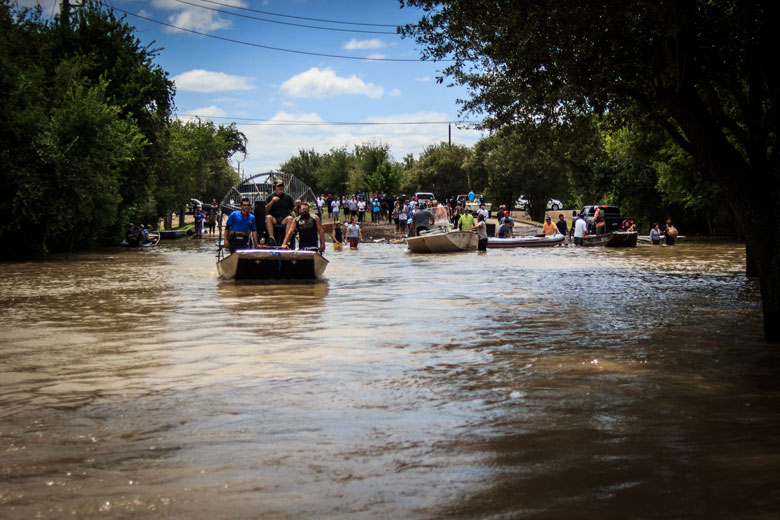
Don’t Become a Casualty – There’s a certain level of emotion when it comes to these situations and for the altruistic it can be difficult to sit back and do nothing when people need help. In these instances be logical, get warm when your crew starts shivering, drink water when you all get hot, get a little sleep when you’ve been running all day. You may miss a few people who need help during your “break,” but you’ll miss many more if you are down for the count and you’ll further absorb precious resources if you become a casualty yourself. Keep the bigger picture in mind.
Before we even drove towards Houston, we’d initially made contact with a Coast Guard unit and were given an address where they wanted to link up with us. From there, each boat we had would be assigned a Coast Guard member and tasked out where needed. Upon arrival, with the flooded highways and the Coast Guard location being deep in the city, we realized there was zero chance we could physically get to their location; we were on our own. Monday morning gave us a better visual of what we were dealing with. It’s difficult to articulate and do justice to how the flooding physically impacted the local areas. I believe that people unfamiliar with flooding simply envisioned that Houston was more or less a giant swimming pool and one could put a boat in on one side and traverse the whole city; this was not the case. Due to the varying topography you had “lanes” of flooding followed by “lanes” of dry land on a small scale, making travel difficult. You could only get so far with a truck, then only so far with a boat, before needing a truck again.
That Monday morning was a little hard on morale; had we come all this way and committed so much time and effort only to be landlocked and not able to help anyone? We continued to talk to people and attempt to make contact with local Law Enforcement and emergency service entities, but they were extremely task saturated and difficult to make contact with, or even get a clear answer from. We got through to a couple of folks and passed our contact information before heading out to flooded neighborhoods to see what we could do. By this point, we had two more boats latched onto our convoy and other volunteers in the same situations as us, ready to help but trying to find work. At last we got a call from a local Sheriffs Office with instructions to meet at a Shell gas station to liaison with the local Sheriff’s Deputies to standby for tasking.
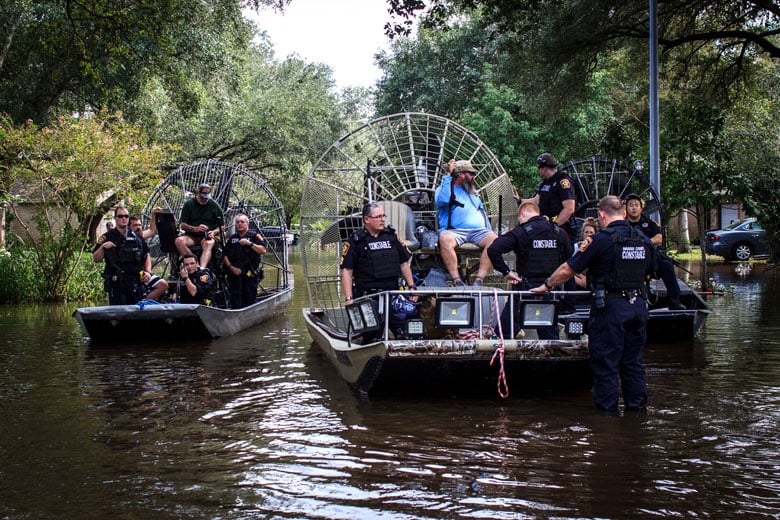
We finally linked with the Harris County Sheriff’s Department and after quickly meeting and discussing our capabilities, we were promptly put to work. The department was in dire need of help, but there was so much confusion and misinformation that they didn’t know how to get through to crews who were there to help and it was difficult for crews to figure out where to go. Rumors reign with situations like these and we kept hearing conflicting reports, which obviously didn’t help matters.
While people had the best intentions by relaying reports, getting accurate information was like playing a game of telephone. In the end, the overarching need for volunteer boat crews was absolutely true, but the specifics on where to go, whom to talk to and where help was needed, was so diluted that it was more of a hindrance than a help. The Sheriffs needed help and we wanted to help, but there was a huge disconnect between us and them, that it took concerted effort to get to that meeting at the gas station.
Lesson 2
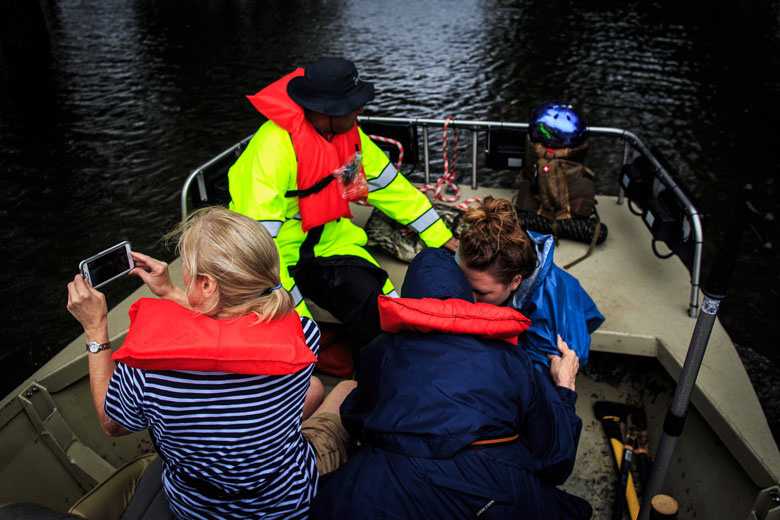
Stay Flexible – Be ready to not only deal with, but to thrive in a dynamic situation. Plan A will crap out, Plan B will never come to fruition and you’ll be lucky if Plan C sticks. In the Marine Corps we used a play on the motto “Semper Fidelis” and that is “Semper Gumby.” You have to be malleable when faced with these circumstances, or you will fail. Any action is better than no action and rather than give up, you have to keep moving forward and realize there are multiple routes to get where you are going; both literally and figuratively.
After the meeting at the Shell station, we gathered into a convoy and were escorted by Police vehicles running code to a neighborhood about ten miles away from a location that many people were stranded at and not many boats could get into. We traveled most of the way, going the wrong way down Highway 290 due to the west side of the highway being under five feet of water. It certainly made for an interesting time going against what little traffic there was. The entire town was a free for all in this aspect.
Airboats, like the ones we were riding on, were a hot commodity. There’s no engine or propulsion system in the water, so there’s nothing for the motor to get caught on. Outboard motorboats were frequently running aground, getting caught on debris in the water and were unable to get into secluded neighborhoods.
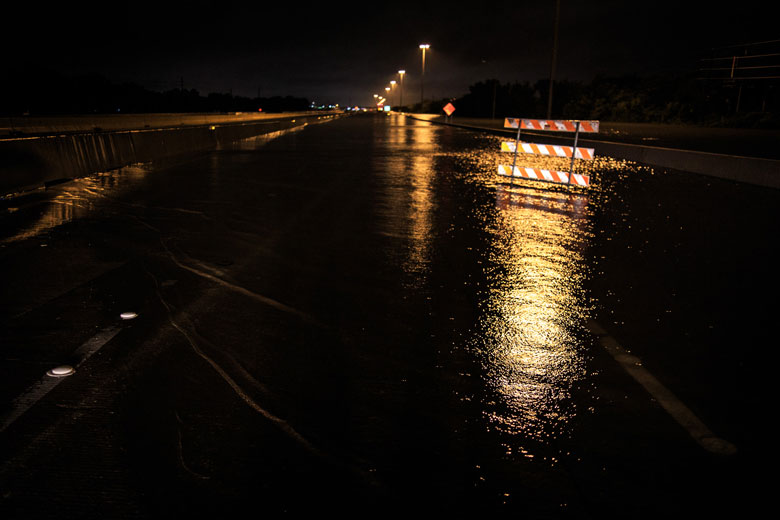
As I stated earlier, the varying topography made for difficult navigation as we couldn’t just follow the streets on a map like normal. We had to pick our way through creeks-turned-rivers, parks, backyards, etc. While I am a huge proponent of always carrying a paper map/atlas with you, because technology does fail, in this instance it would have proved worthless. A waterproof/laminated map of the area would have been nice, but we didn’t know where we’d be working until thirty minutes before we got there and we needed close-in street level maps of the area.
At one point we had to pick our way through two neighborhoods, then two miles up a flooded creek in order to get to a neighborhood that had been utterly cut off. Using the map app on our phone saved us significant time and wasted effort in this endeavor. The constant rain made the phone difficult to use (ever use a mildly wet touch screen phone? It’s a good time) but we made do with what we had.
The Sheriff’s radio was also wet and difficult to use. There was so much radio traffic that at some points, it was all but impossible to pass or receive information. It simply became easier to use the phone to call back to the command post, get an address and plug that into the map application, rather than trying to listen to cross streets and addresses over a congested radio channel. At this point I was also getting numerous addresses of people needing to be rescued via Facebook, text, etc. I actively passed these onto the LEOs we were working with.
Lesson 3
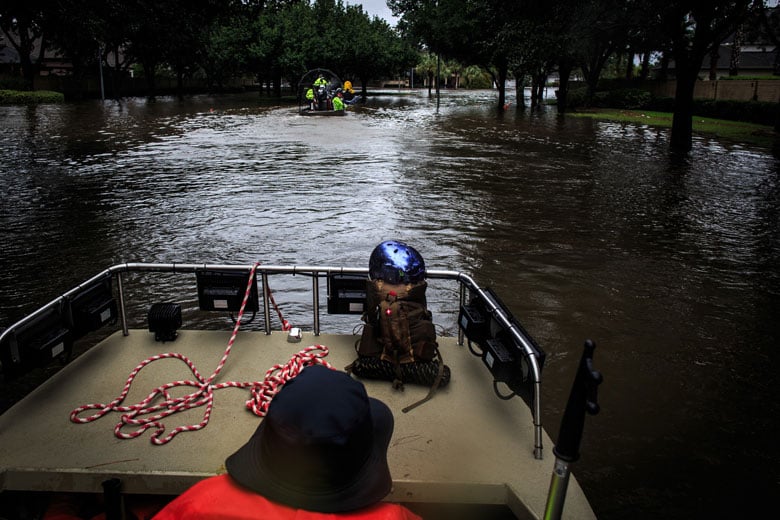
Smartphones are Extremely Powerful Tools – Smartphones can be a valuable resource in a bad situation, especially if you have any sort of reception. You can view maps, look up data and communicate effectively. Keep your phone charged and functioning. Get a Lifeproof Case for your phone, even if you’re not around water, these cases are proven andI’ve been using them for years now. If you take care of them, they will stay completely waterproof and absolutely work. I prefer the Lifeproof Nüüd to the Lifeproof Fré, but either will work. Carry a portable charger and cable with you so that you aren’t tethered to a wall outlet.
I have a couple different “power bricks” of varying sizes but my workhorse is an Anker 20100. I can get four full-charges on my iPhone 7 Plus with this and do this on the go at anytime, even when there are no receptacles, or the power is out. I personally believe portable chargers are the way of the future and that more and more electronics will eventually migrate to being USB chargeable. You can now get very small pocket-sized chargers that are good for at least one charge if you need to minimize.
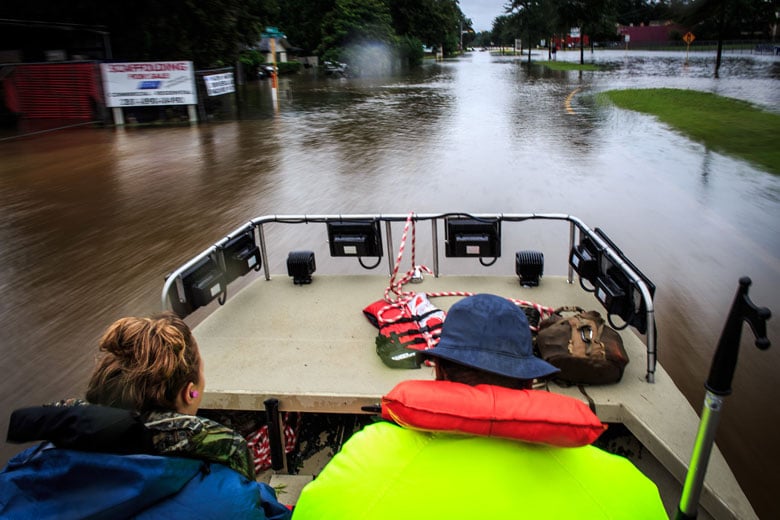
We spent the rest of Monday and Tuesday working over a couple neighborhoods in Cypress. We rescued multiple children, adults, elderly and even dogs, cats and one turtle. Our plan of attach was to get an address and go attempt a rescue. However, roughly half the rescues we did were people we saw en route to our tasked rescues. After picking folks up, we’d take them to the launch point, which was generally in the middle of the road where the waters stopped and handed those rescued over to other volunteers, who would shuttle them over to shelters, or work with them to be picked up by friends.
Often times these folks would be carrying multiple bags, suitcases, garbage bags full of personal items and unfortunately, we had to make them leave most of it behind due to weight and room constraints on the boats. The more baggage people carried, the less people we could pick up. By the time we got many of these folks to dry land, all they had on them was a small back pack of whatever they deemed valuable to take with them. They were forced to leave most everything they owned in the world behind and most of these folks were ill prepared for that. We did have a couple ideal rescues, who were folks that packed light and were ready to go as soon as we pulled up. They also all had some type of signaling device to get our attention; white sheets and pillow cases worked well. They also moved with a sense of urgency and did what we told them to, when we told them to do it.
We pulled this “operation” off all on our own and it was a true test of our level of preparedness. There were very few stores open, very few gas stations that had gas and very few places to sleep with a roof over your head. We had to bring our own food, water and fuel, as well as make our own sleeping arrangements. Fortunately we found a local hotel for the last two nights that had squirreled away a couple rooms specifically for rescue crews, but the first night we slept for about an hour total in the seats of an uncomfortable truck. Those who were most prepared fared better than those who weren’t and this went for both rescue crews and people needing to be rescued, it was as simple as that.
You may be in the middle of a suburban neighborhood, or in the middle of a city, but in a disaster situation you may as well be in the backcountry in regards to the resources available to you. We as a society have a very heavy consumer dependence and the luxury of being able to go to the store and buy food when were hungry and head to the gas station when we need gas; we often take these things for granted. When those amenities disappear, you have to be prepared to deal with it, or you’ll be calling for crews like mine to come rescue you and your family.
Lesson 4

Maintain Preparedness and Self-Sustainment at All Times – Don’t wait until disaster strikes to get prepared, this goes for both rescue crews and everyday civilians. If you are a follower of ITS Tactical, you’re more than likely on your way to becoming self-sufficient, if you aren’t there already. Keep in mind that you’re also the minority. Maintain your food supply levels with items that you can consume without power or gas and keep multiple days worth of water on hand.
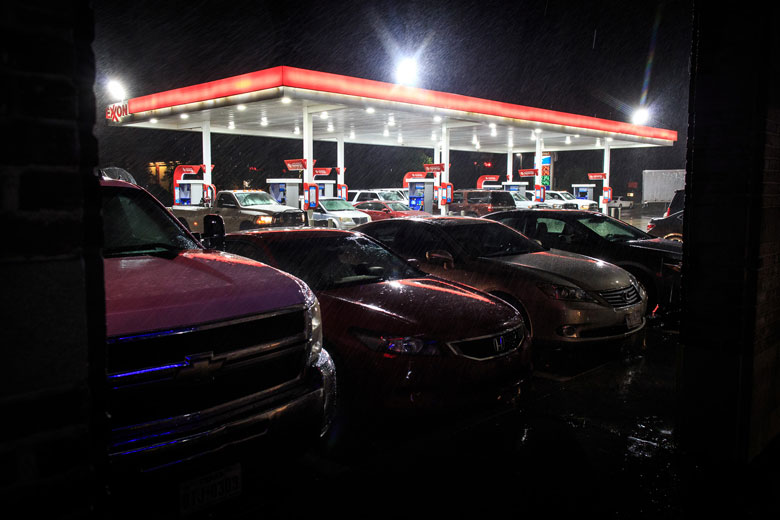
Have clothing designed for inclement weather, maintain proficiency in the use of a firearm and have a plan for you and your family should the worst happen. Don’t forget to rehearse the plan too. Anyone who maintains a “bug out bag” has probably been given a hard time at some point by friends and/or family, but when SHTF, you’re the one people turn to.
Here’s a list of equipment that came in handy during our Hurricane Harvey evolution, in no particular order:
- Rite-in-the-Rain Notepad – Invaluable for recording addresses and information in the pouring rain. I used mine in the literal sense of the name and they work as advertised. I highly recommend them as well in a zippered cover.
- A good high-lumen flashlight and headlamp with extra (Lithium) batteries for both.
- Tent, sleeping pad and pillow.
- Quality rain gear, hat and a change of dry clothes and shoes. Make sure they stay dry! Putting on cold and wet “dry” shoes after a long day on the water sucks.
- A durable waterproof bag of some sort; Sea-to-Summit or Outdoor Research bags work well for this.
- A good, sharp, fixed blade knife.
- Zip Ties, Duck Tape, 550 cord and a length of rope.
- For those in a boat or vehicle, a good tool set with sockets and crescent wrenches.
- Insulated and sealable bottle, like a Hydro Flask or Yeti; having something warm when you’re perpetually wet is huge for morale.
- A good set of polarized sunglasses, I recommend Costas.
- Mid-range binoculars
- If you’re in a boat, a quality, well-fitting life preserver. Kayak and White Water rated PFDs work well for this.
For those stuck in hard hit areas that need to be rescued, the following equipment list will apply:
- All of the equipment from the previous list.
- Food that you can eat without cooking or even heating with a camp stove.
- Have a reasonable sized backpack ready to go with personal belongings when the rescuers arrive and make sure your family has the same.
- Be familiar with the streets and areas around your home, know the GPS coordinates for your home.
- Have some kind of big, bright signaling device. While you’re specifically looking for rescuers, they’re looking at everything in the neighborhood. We missed multiple people who thought we could see them waving from a random window. Use big exaggerated motions, waving a white sheet will get rescuers attention and let them know you need help.
- Be patient – If you see a rescuer, they may be on the way to conduct a life-threatening rescue. If you are safe and you are waving a white flag, we know where you are and we (or another crew) will come back to get you.
- When passing your home information via text, social media, etc., type out your address in its entirety and post/send it in its own post/message. Then take a map screen shot and post that in its own message as well. Include a time and date. We were very task saturated and it got to the point where we simply ignored partial addresses, addresses imbedded in a long message, or messages that had only a screenshot with no address listed at all. Phones are hard to use when wet and if I couldn’t easily copy and paste it and have a visual of what part of town it was in, we didn’t get to it. I know it seems trivial, but we were so busy with reports coming in, that our phones were difficult to use for fine tasks.
- Follow the instructions of the rescue crew, once they get to your location move with a sense of urgency. You aren’t the only one that needs to be picked up. We had multiple people wave us down frantically, then move lackadaisically once we got there.
Wrap Up
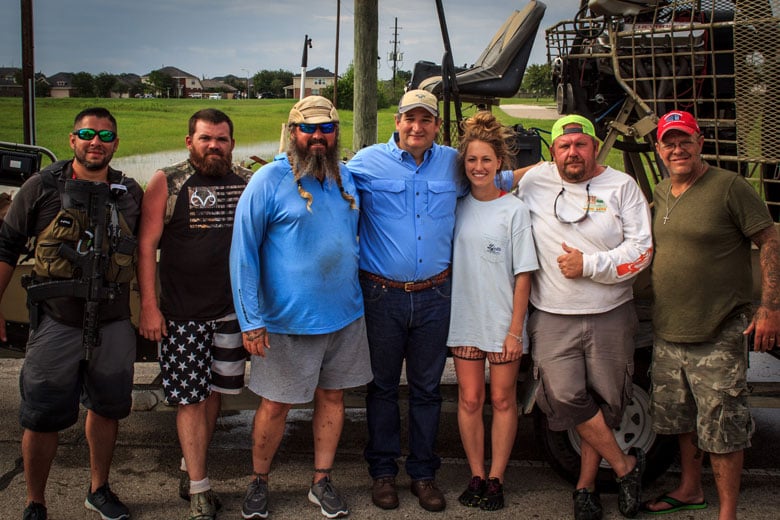
Given the current climate in this country, it was extremely refreshing to see everyone come together and act as one for the sake of their fellow man. There was no talk of politics or statutes and society became beautifully simplistic; survive and help other people survive.
As I write this, Hurricane Irma is bearing down on the state of Florida and we will once again witness a unique level of humanity during the aftermath. While my crew will be headed out once again to help come morning, I’ll have to sit this one out due to work constraints. For those who live there and those who are venturing out to help, Godspeed, semper paratus and watch your six!
Editor-in-Chief’s Note: Daniel is a former US Marine Corps aerial gunner, photographer and a Mountain Sports of Arlington kayak fishing team member. You can often find him yak-packing (kayak camping trips), chasing storms or adventure and hunting. All of the photos in this article were taken by Daniel, check out his website here and also the kayak fishing blog he runs with his dad.






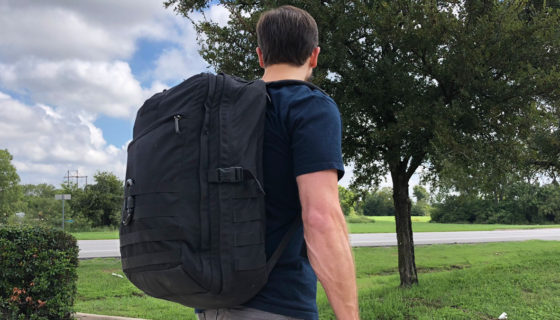
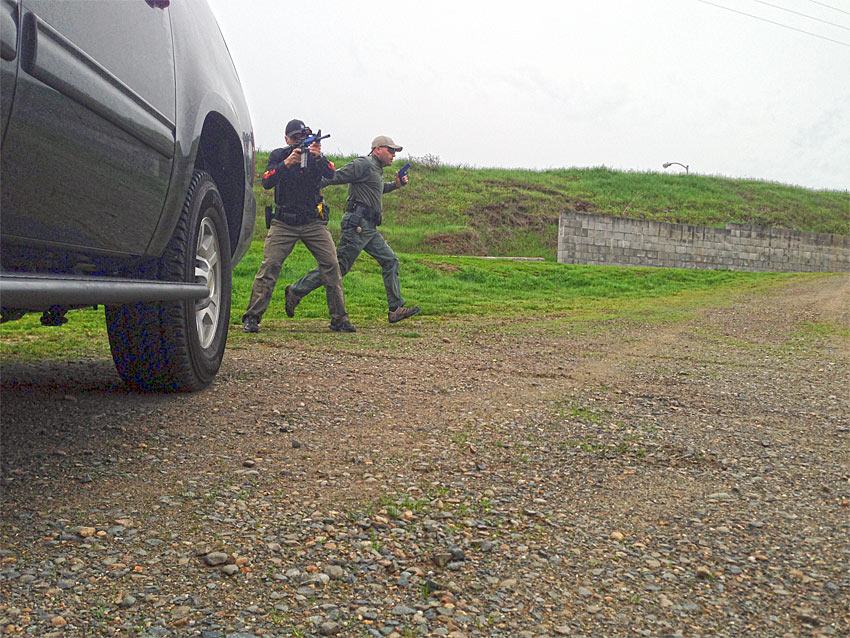
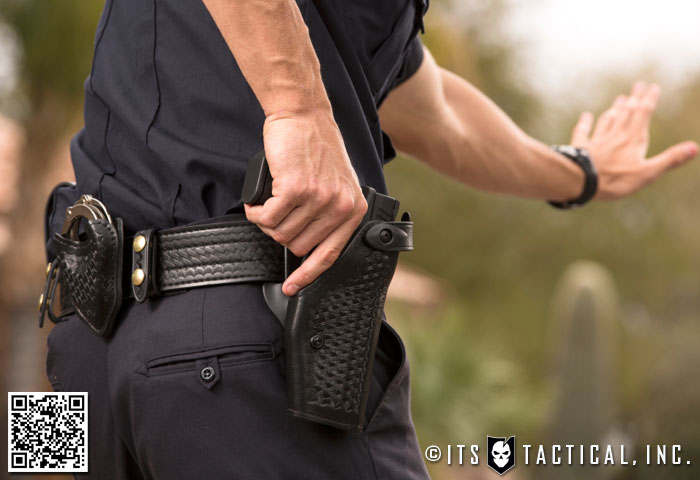
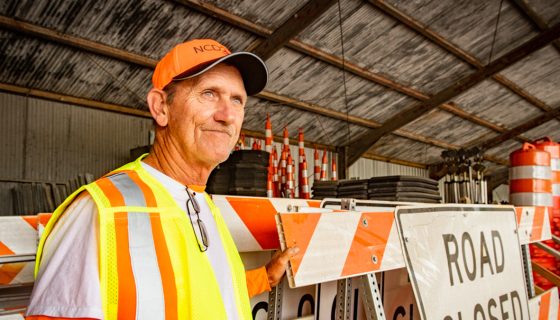

Discussion